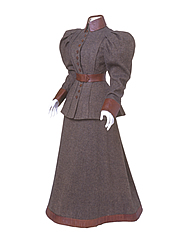WOMEN'S
FASHION HISTORY EXPLORED IN NEW EXHIBITION
Exhibit
depicts the history of Atlanta's women through clothing
 |
| Bicycling
ensemble, ca. 1895. Like other physical activities, the bicycling
craze of the 1890s required special clothing. While some women
donned bloomer costumes, an early type of trousers, many shied
away from this controversial style due to its association
with the suffrage movement. The heavy leather trim at the
skirt of this wool tweed ensemble helped ensure modesty, even
on windy days. Worn by Sarah Frances Grant Slaton. Photo
by Jonathan Hollada; Atlanta History Center |
Expanding
on the idea that fashion both reflects and defines the
moment in which it was created, the Atlanta History Center has
produced a new exhibition depicting the lifestyle and costume changes of
Atlanta women.
Beginning
November 1, 2003, through April 18, 2004, the Center will feature Gone with the Girdle: Freedom, Restraint and Power in Women's
Dress, a 3,300 square-foot exhibition that examines the silhouettes
and experiences of Atlanta women from the city's early days to
the present. While the setting may be Atlanta, the clothing follows
the timeline of any city's women - reflecting their dreams, challenges
and successes - from the confining corsets of the 19th century
to today's urban chic.
The
exhibition features a range of clothing and accessories from vintage
to contemporary, along with historic photographs and stories told
in women's own words through letters, diaries and interviews.
This mix of object, image and word enables visitors to meet generations
of working women and mothers, teachers and volunteers, role models
and less traditional women who
together make up the body of Atlanta women's history.
Among
special topics highlighted in the exhibition are the evolution
of undergarments, rise of athletics, changing mourning rituals
and timeless accessories including hats and shoes.
"The
History Center's textile collection includes more than 10,000
artifacts. Highlighting a number of these garments and accessories
- many of which are rare and extraordinary - is a tremendous opportunity
for us to share our scholarship and collections," said Jim
Bruns, executive director of the Atlanta History Center. "This
exhibition, the result of a two-year research effort at the Atlanta
History Center, explores the way women were frequently bound by
custom and costume."
Gone
with the Girdle illustrates changes in silhouettes and related
undergarments over time, explores Atlanta women's access to fashion
and considers the relative freedom of contemporary women to express
themselves through clothing. More than sixty ensembles are presented
from five eras that redefined women's roles:
- Women on Pedestals represents mid-19th century Atlanta as the
city matured from its rough, merchant-town youth to reflect
the patriarchy of the plantation system in the American South.
An olive green silk brocade day dress highlighted in this section
shows that, in 1860, up-to-the-minute fashion made its way to
the frontier.
- Women on Parade picks up around the turn of the century, when
Atlanta women became more visible in public life. They initiated
reform movements, campaigned for the vote and increasingly worked
for wages. By the 1920s, many women embraced modernity with
shorter dresses, bobbed hair and daring dances. A brown tweed
bicycling suit with leather trim, circa 1895, reflects the freedom
associated with the era's bicycling craze.
- Women in Pants introduces visitors to the eras of the Depression
and World War II, when the landscape of women's employment changed.
After their wartime contributions, many women continued to work
outside the home, but were typically relegated to the bottom
rung of the economic ladder-unskilled jobs with low wages. However,
not all women's roles were menial, as exhibited in an adventurous
female pilot's flight suit and accessories, circa 1935.
- Women in Politics witnesses the many challenges to earlier concepts
of women's roles, rights and sexuality during the third quarter
of 20th century. Many important individual and collective "firsts"
for women occurred and women's changing status was reflected
in clothing, laws, advertising, movies and television. Embroidered
denim hip hugger jeans and a matching jacket from the early
1970s help bring this era to life.
- Women
Share Power finds us on the threshold of a new century we consider
how far women have come in the quest for equality. The incredible
freedom Atlanta women share bears the weight of responsibility.
Can women have it all, do it all, and at what cost? And who
are Atlanta women today? An emblem of this section is a dark
blue United Nations/U.S. Police Monitor uniform worn in Bosnia
Herzegovina in 1998-1999.
The
Atlanta History Center is open Mon.-Sat., 10 a.m.-5:30 p.m. and
Sun., noon-5:30 p.m. Admission is $12 for adults, $10 for students
13+ and seniors 65+, $7 for youths 4-12 and free for children
3 and under.
For
more information, visit www.AtlantaHistoryCenter.com. |